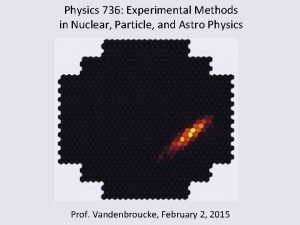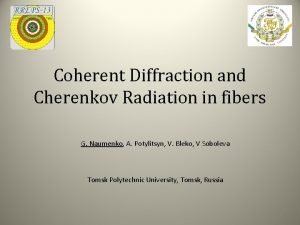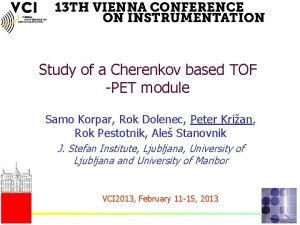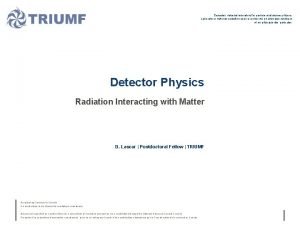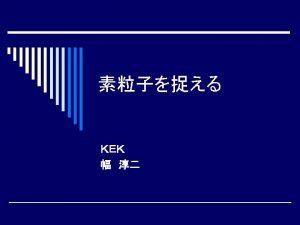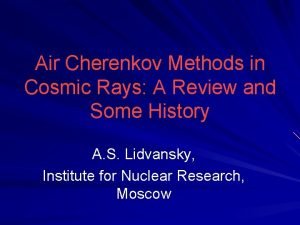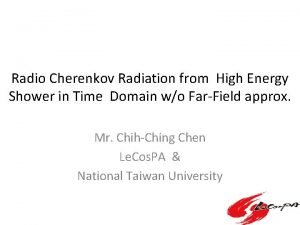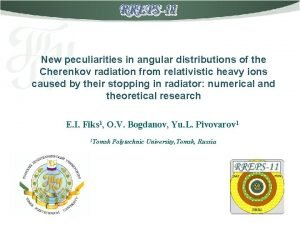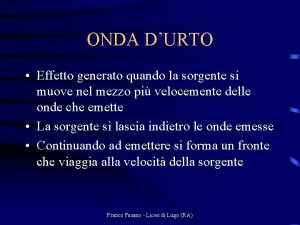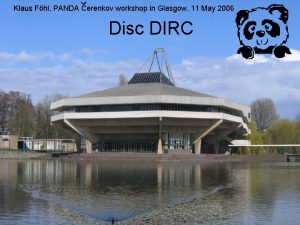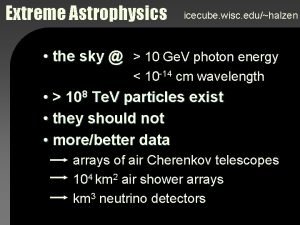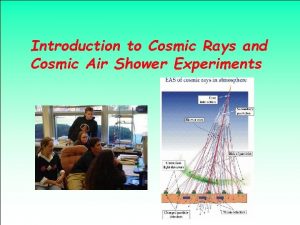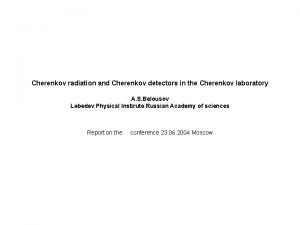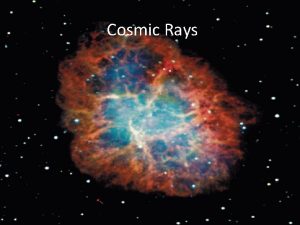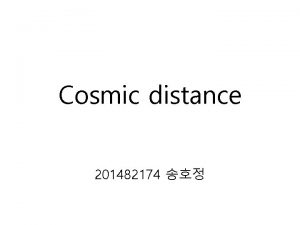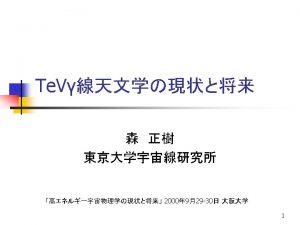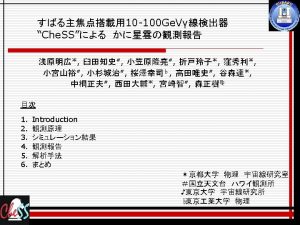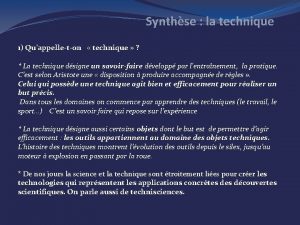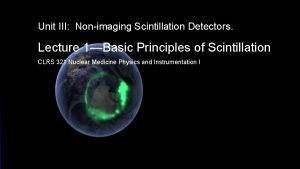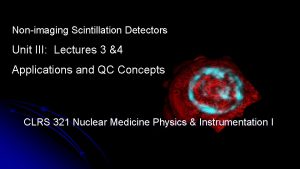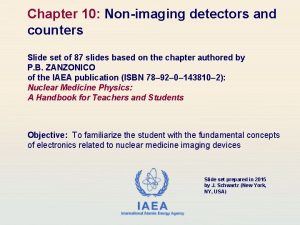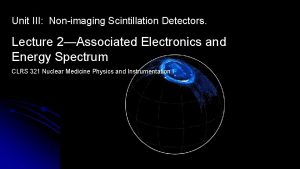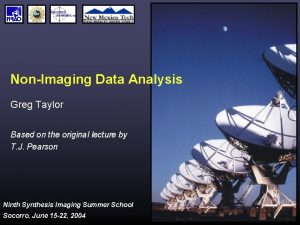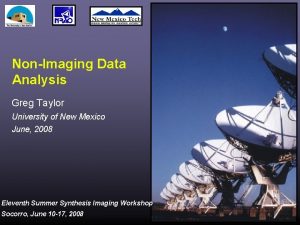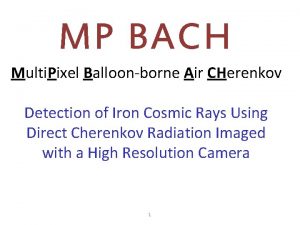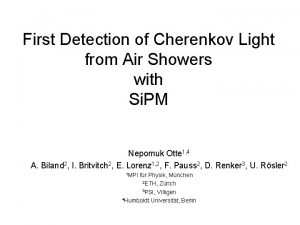Nonimaging Air Cherenkov Technique for studies of Cosmic























































- Slides: 55

Non-imaging Air Cherenkov Technique for studies of Cosmic Ray Origin and Gammaastronomy. L. A. Kuzmichev (SINP MSU) On behalf on the Tunka and SCORE Collaboration February, 2011

Abstract • Non-imaging Air Cherenkov Technique is described by using the Tunka-133 array and the SCORE project as an examples. The Tunka-133 is a 1 km 2 array started to operate in autumn of 2009 in the Tunka Valley, 50 km from the Lake Baikal. The main goal of the array is to study energy spectrum and mass composition in the energy range of 1015 1018 e. V. • SCORE is a project of 10 km 2, low threshold array. The main goal is to search of gamma-quanta with energies above 30 Te. V (origin of cosmic rays) and to study cosmic rays with energies of up to 1018 e. V. It is planned that the first stage of SCORE ( 1 -2 km 2 ) will be installed in the Tunka Valley for joint operation with the Tunka-133 array.

OUTLINE 1. Non-imaging Air Cherenkov Technique 2. Tunka-133: construction and deployment. 3. Results after first season. 4. Plan for the Tunka-133 upgrading. 5. SCORE project. 6. Cherenkov Technique at Mounting Level

P, A Atmosphere as a huge calorimeter For Ee >25 Me. V Ve > C/ n – light velocity in air Cherenkov light Q tot N(x) dx ~ 20 -30 km E Lateral Distribution Function Photons detectors E (Pe. V) = 0. 4 Q(175) ph· ev-1 cm-2

Advantage of Cherenkov Technique: 1. Good energy resolution - up to 15% 2. Good accuracy of Xmax - 20 -25 g/cm 2 3. Good angular resolution - 0. 1 – 0. 3 deg 4. Low cost – Tunka-133 – 1 km 2 array: 0. 5 106 $ ( construction and deployment) + 0. 2 106 $ ( PMTs) Disadvantage: 1. Small time of operation ( moonless, cloudless nights) – 5 -10%

Light background Signal S • Qph(175) • = noise • S • Iph • T Energy threshold of Cherenkov array 3 Qph(175 ) = C · E Eth ~ Iph • • T S • for S =0. 1 m 2 и 0. 1 : Eth 100 Te. V S– area of PMT photocathode - quantum efficenty Qph (R) –Cherenkov light flux T - duration of pulse ( 20 – 40 нс) - angle of view Iph – light night background 2. 108 ph/cm 2 s

Usage of Cherenkov Light Lateral Distribution Function (LDF) for the Reconstruction of EAS Parameters LDF from CORSIKA Experimental data fitted with LDF Q(R) = F(R, p) (only one parameter) light flux at core distance 175 m - Q 175 Energy steepness of LDF P = Q(100)/Q(200) Xmax

CORSIKA Cherenkov light density at 175 m from the shower core Energy determination: E = C· Q(175)094 Lg( E/E 0) Lg(Q(175) / ph· ev-1 cm-2 ) Energy resolution ~ 15%

Absolute calibration of energy measurement E Q(175) • 1. To measure light flux with good accuracy we need to know PMTs quantum efficiency and light attenuation. Difficult but possible. • 2. Another approach – how to avoid measurement of quantum efficiency and light attenuation - experiment QUEST at Gran-Sasso.

Experiment QUEST – QUSARS at EAS-TOP • EAS-TOP array at Gran-Sasso (Italy) – Ne and core position. Cherenkov detectors – LDF and P =Q(100)/Q(200) For P we not need to know the absolute value of quantum efficiency PMT QUASAR-370 ( 37 cm photocathode diameter) Used in Baikal Neutrino experiment NT 200 and Tunka-25

No dependence from Hadronic model p

Model independent intensity of CR flux from QUEST experiment. Tunka experiment is normalized to this intesity.

Xmax determination 1. Steepness of LDF: Xmax = F( P) 2. Width of light signal : Xmax = F( τ ) 3. Shape of Cherenkov front : Xmax = F(a) ( not used up to now) a

Xmax by steepness LDF Hmax (km ) = 14. 07 – 2. 33 · P

X max by using WIDTH DISTANCE FUNCTION (WDF) X =X 0 cos Xmax ( X 0 – depth lg (R) WDF (R, (400 ) of the atmosphere 400 Dependence of pulse duration from the distance from the core for EAS with different Xmax ( CORSIKA + apparatus distortion) ( 1 . X= 154 г см 2 , 2 X= 555 г см 2, 3. X=877 г см 2) . Dependence of X (X 0 cos Xm from (400)

Tunka-133 – 1 km 2 “dense” EAS Cherenkov light array Energy threshold 1015 e. V Accuracy: core location ~ 6 m energy resolution ~ 15% Xmax < 25 g∙cm-2 S (Tunka-133) = 30 S (Tunka 25)

Search for the Acceleration Limit of Galactic Sources - Energy range 1016 -1018 e. V demands: - 1 km² with spacing smaller than that at Auger - complementary techniques - KASCADE-Grande - Ice. Top/Ice. Cube - Tunka-133 (calorimetric) - NEVOD-DÉCOR - Auger low energy extension - SCORE -LHAASO terminated 100% ready in operation 80% ready planned Tunka-133 Ice. Top Ice. Cube ? CR from SNR CR from AGN

Tunka-133: 19 clusters, 7 detectors in each cluster DAQ center Optical cable Cluster Electronic box PMT EMI 9350 Ø 20 cm 4 channel FADC boards 200 MHz, 12 bit

Array deployment Optical cables Detectors Testing PMTs

1. ADC AD 9430, 12 bit, 200 MHz 2. FPGA XILINX Spartan-3 4 channel FADC Cherenkov light pulses at two detectors of the cluster at core distance~ 700 m t ( 5 ns)

Optical detector of Tunka-133 PMT EMI 9350 Ø 20 cm Angular sensitivity

First season of operation: November 2009– March 2010 286 hours of good weather. > 2 106 events with energy 1015 э. В. 10 events during every night with number of hitted detectors more than 100. 50 detectors 1016 e. V Distribution of the number of hitted clusters in one event. Trigger counting rate during one night.

Example of event Energy: 2. 0 1017 e. V zenith angle : 12. 6 ° 125 detectors Core position: LDF -method WDF -method R lg ( I light )

Lg Qexp (R ) Lg (R ) LDF WDF Thershold A. A– Fitting experimental points with LDF B – Fitting of ( R) with Width – Distance Function. B

Combined spectrum 182 event 353 g 1 Tunka 25( ) plus Tunka 133 ( ) g 1 = 3. 2 g 2 = 3. 0


353 events 4. 2 277 Good pointing for the existing of “ bump”

Tunka-133 Gamma

Plan for Tunka-133 upgrading - Far distant clusters for encreasing effective area - Scintillation muon counters E 0 , Xmax ( from Tunka-133 ), Nµ - Low threshold array

. 6 additional clusters ( 42 detectors) 1 km Increasing Effective Area in 4 times for energy more than 1017 e. V Statistics in 2012 ( > 1017 e. V) : 600 (inner events) + 800 (out events) All: 1400 events In operation

SCORE project – wide-angle gamma-telescope with area 10 -100 km 2 and threshold 30 тэ. В (M. Tluczykont et al , Ar. Xiv: 0909. 0445) SCORE: Study for Cosmic ORigin Explorer Increasing area of PMT with Winston cone First SCORE Station will be tested at Tunka in this summer


Distance between station - 100 -200 m Angular resolution: < 0. 1°

The Physics Motivations: Cosmic Ray Origin Search for the Pevatrons: gamma-quanta with energy >100 Te. V only from hadronic mechanism Propagation and Absorption of gamma-rays ( photon/axion conversion or Lorentz violation) Dark matter Axion as CDM candidate


Cherenkov Technique at Mounting Level. For good energy resolution Xmax < X 0 ( depth of Atmosphere ) – “thick calorimeter”

Cherenkov Technique at Mounting Level 1. Low energy E < 200 -300 Te. V 2. Large zenith Angle > 45°

LDF for 100 Te. V gamma (zenith angle = 0°) Tunka level LHAASA level Difference seems not too dramatic but should take into consideration 2 times

X 0 / cos 45 Xmax distribution For proton with energy 1017 e. V

Very large area of muon detectors at LHAASO gives: 1. High factor of gamma-hadron separation for SCORE –like array. 2. Essential increasing of the accuracy of mass composition study at 1016 -1018 e. V 3. Good sensitivity to ultra high energy gamma radiation

Muon number vs. Xmax Fe, Si AIRES 2. 8. 4 a QGSJET-II Eµ > 1 Gev, θ = 0° Nµ /Nµ = 10%, Xmax = 20 g/cm 2 p ( 500 events) He ( 500 events) Si (500 events) Fe ( 500 events) p, He lg. Nµ (corr)= lg. Nµ - Xmax - 600 1500 lg. Nµ Xmax

Search for diffuse gamma-radiation

766 г/см 2 675 г/см 2 Log Nmu

Search for diffuse gamma radiation at high energy

Conclusion 1. Non-imaging Air Cherenkov Technique is rather well understood technique. High energy resolution – 15 -20%, high accuracy for Xmax - 20 g/cm 2 2. The TUNKA-133, presently the largest Air Cherenkov Array in the world, is operating now and provides very interesting results. The upgrading of the array will start in 2011 3. The SCORE is very perspective project for Very High Energy gamma-ray astronomy and Cosmic Rays physics. 4. Operation of SCORE and TUNKA like arrays (for large zenith angles) at the LHAASA altitude seems very interesting.

Thank You



Tunka Collaboration S. F. Beregnev, N. N. Kalmykov, E. E. Korosteleva, V. A. Kozhin, L. A. Kuzmichev, M. I. Panasyuk, V. V. Prosin, A. A. Silaev(ju), A. V. Skurikhin, I. V. Yashin, A. V. Zablotsky – Skobeltsyn Institute of Nucl. Phys. of Moscow State University, Moscow, Russia; N. M. Budnev, A. V. Diajok , O. A. Chvalaev, O. A. Gress, A. V. Rjchanov, A. V. Korobchebko, R. R. Mirgazov, L. V. Pan’kov, Yu. A. Semeney, A. V. Zagorodnikov – Institute of Applied Phys. of Irkutsk State University, Irkutsk, Russia; B. K. Lubsandorzhiev, B. A. Shaibonov(ju) – Institute for Nucl. Res. of Russian Academy of Sciences, Moscow, Russia; V. S. Ptuskin – IZMIRAN, Troitsk, Moscow Region, Russia; Ch. Spiering, R. Wischnewski – DESY-Zeuthen, Germany; A. Chiavassa – Dip. di Fisica Generale Universita' di Torino and INFN, Torino, Italy. D. Besson, J. Snyder, M. Stockham Department of Physics and Astronomy, University of Kansas, USA

E 0 ~ Q (175 m) Registration of Cherenkov light from EAS Ln(1/A) ~ Xmax θ, φ Xmax Methods of Xmax measurement: 1. Steepnes of LDF: P ~ Hmax, km Hmax=(T 0/grad(T)((Xmax cosθ /X 0)C/grad(T) - 1) – Harr)/cosθ 2. Signal duration ~ ΔX g/cm 2 ΔX = X 0/cosθ – Xmax X 0

The main aim of experiment: Detailed study of cosmic rays energy spectrum and mass composition in the energy range 1015 – 1018 e. V with Cherenkov light array of about 1 km 2 area Is there an “iron knee” above the classical knee at 3∙ 1015 e. V? What is the mass composition above a possible iron knee? Is this region dominated by the sources different to supernova remnants? Does “second knee” at 1017 - 1018 e. V exist? Is it caused by the end of the galactic component?

No “bump” in Kaskade-Grande Spectrum ( ar. Xiv: 1009. 4716) We need more statistic and knowing of mass composition

Time callibration

Amplitude calibration

Methods for the core reconstruction and X max determination • 1. By using Lateral Distribution Function (LDF) • 2. By using Width Distance Function (WDF)
 Cherenkov spectrum
Cherenkov spectrum Cherenkov radiation
Cherenkov radiation Cherenkov spectrum
Cherenkov spectrum Cherenkov
Cherenkov Cherenkov light
Cherenkov light Cherenkov radiation
Cherenkov radiation Cherenkov
Cherenkov Cherenkov light
Cherenkov light Cherenkov
Cherenkov Hadonic
Hadonic Cherenkov radiation formula
Cherenkov radiation formula Effetto cherenkov
Effetto cherenkov Cherenkov radiation
Cherenkov radiation Cherenkov radiation
Cherenkov radiation Cosmic air flights
Cosmic air flights Hubungan air dengan tanah
Hubungan air dengan tanah Paradigm shift from women studies to gender studies
Paradigm shift from women studies to gender studies Kontinuitetshantering i praktiken
Kontinuitetshantering i praktiken Typiska drag för en novell
Typiska drag för en novell Tack för att ni lyssnade bild
Tack för att ni lyssnade bild Vad står k.r.å.k.a.n för
Vad står k.r.å.k.a.n för Shingelfrisyren
Shingelfrisyren En lathund för arbete med kontinuitetshantering
En lathund för arbete med kontinuitetshantering Underlag för särskild löneskatt på pensionskostnader
Underlag för särskild löneskatt på pensionskostnader Personlig tidbok för yrkesförare
Personlig tidbok för yrkesförare A gastrica
A gastrica Förklara densitet för barn
Förklara densitet för barn Datorkunskap för nybörjare
Datorkunskap för nybörjare Boverket ka
Boverket ka Hur skriver man en debattartikel
Hur skriver man en debattartikel Delegerande ledarskap
Delegerande ledarskap Nyckelkompetenser för livslångt lärande
Nyckelkompetenser för livslångt lärande Påbyggnader för flakfordon
Påbyggnader för flakfordon Vätsketryck formel
Vätsketryck formel Publik sektor
Publik sektor Lyckans minut erik lindorm analys
Lyckans minut erik lindorm analys Presentera för publik crossboss
Presentera för publik crossboss Vad är ett minoritetsspråk
Vad är ett minoritetsspråk Bat mitza
Bat mitza Klassificeringsstruktur för kommunala verksamheter
Klassificeringsstruktur för kommunala verksamheter Luftstrupen för medicinare
Luftstrupen för medicinare Claes martinsson
Claes martinsson Cks
Cks Lågenergihus nyproduktion
Lågenergihus nyproduktion Mat för unga idrottare
Mat för unga idrottare Verktyg för automatisering av utbetalningar
Verktyg för automatisering av utbetalningar Rutin för avvikelsehantering
Rutin för avvikelsehantering Smärtskolan kunskap för livet
Smärtskolan kunskap för livet Ministerstyre för och nackdelar
Ministerstyre för och nackdelar Tack för att ni har lyssnat
Tack för att ni har lyssnat Vad är referatmarkeringar
Vad är referatmarkeringar Redogör för vad psykologi är
Redogör för vad psykologi är Borstål, egenskaper
Borstål, egenskaper Tack för att ni har lyssnat
Tack för att ni har lyssnat Borra hål för knoppar
Borra hål för knoppar Vilken grundregel finns det för tronföljden i sverige?
Vilken grundregel finns det för tronföljden i sverige?
